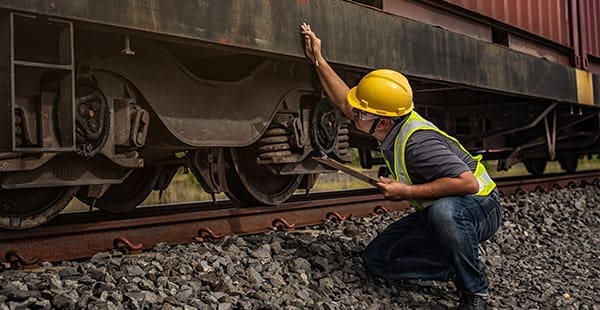01. Asbestos Risk
How Are Railroad Workers Exposed to Asbestos?
For decades, railroad companies exposed workers to asbestos. The mineral was used in railroad products from at least the 1930s until the 1980s. Asbestos was especially common during the era of steam trains through the 1950s.
Companies used asbestos in many applications where heat and friction resistance were needed. As asbestos-containing materials become worn or damaged, they can release harmful fibers. Even handling intact asbestos materials poses these exposure risks.
Asbestos was used in many products found in rail houses, railcars, repair shops and more. As a result, various workers were at risk of asbestos exposure. This includes those who laid down tracks, repaired equipment and operated locomotives.
Although asbestos use in the railroad industry stopped in the 1980s, old products can still pose an exposure risk. As the products age and deteriorate, asbestos fibers may become airborne. Inhaling or ingesting these fibers is harmful. It can cause mesothelioma and other asbestos cancers.
These factors combined make railroad workers an at-risk asbestos occupation.
What Asbestos Products Put Railroad Workers at Risk?
The railroad industry used many asbestos products, putting workers at risk of exposure. Asbestos insulation was particularly common in the railroad industry. It was used in boilers, electrical panels, engine rooms and other components facing high temperatures.
Railroad workers may have been exposed to asbestos from:
- Boilers
- Brake linings
- Brake pads
- Ceiling tiles
- Cement
- Cement ties
- Clutches
- Electrical panels
- Felt
- Fireboxes
- Floor tiles
- Gaskets
- Insulation
- Paint
- Pipe covering
- Plaster
- Rail tiles
- Roof panels
- Siding
- Steam engines
- Wallboard
The asbestos companies and railroad companies that made or used these products put railroad workers at risk. Manufacturers that supplied asbestos products to railroad companies include:
- Abex Corporation
- American Standard Inc.
- The Flintkote Company
- General Motors
- H.K. Porter Company
- Johns-Manville
- Keasbey & Mattison Company
- Railroad Friction Products Corporation
- Raybestos-Manhattan Inc.
- Russell & Company
Some companies were aware of the products’ dangers and continued to use them anyway.
Common Places Railroad Workers May Find Asbestos
All train types may have contained asbestos, including freight and passenger trains. It was also used throughout rail yards, rail shops and other areas in the railroad industry.
Asbestos materials were most common in areas facing high temperatures, friction or heavy use in the railroad industry. Locations in the workplace that exposed railroad employees include:
- Blacksmith shops
- Boiler rooms
- Boxcars
- Cabooses
- Engine rooms
- Freight car shops
- Frog shops
- Locomotive shop fan houses
- Passenger car and wheel shops
- Passenger cars
- Train carriages
Asbestos was particularly common in steam engines. Boilers are the main component of steam engines. Fuel powered the boiler to heat water and convert it into steam. As a result, the boiler reached extreme temperatures. Asbestos insulation in the boiler room helped equipment withstand this heat and prevent fires.
The boiler room and other parts of the train could have poor ventilation. Less ventilation allows for higher concentrations of asbestos fibers. This could pose a greater risk of exposure for those in the area. However, no amount of asbestos exposure is safe.
Railroad Workers and At-Risk Trades
Other than railroad workers, related jobs in construction and transportation industries also have histories of asbestos exposure. Many used the same kinds of products and may have been exposed on the job.
Similar at-risk occupations include:
- Baggage handlers
- Boiler workers
- Brake operators / brakemen
- Car couplers
- Conductors
- Construction workers
- Cooks
- Delivery truck drivers
- Electricians
- Engineers
- Freight workers
- HVAC workers
- Hydraulic engineers
- Insulators
- Machine operators
- Machinists
- Merchant Mariners
- Plumbers
- Refrigeration engineers
- Riggers / doggers
- Shipyard workers
- Switch operators / switchmen
- Train crews
- Water transportation workers
- Yardmasters / inspectors
Several other trades were also at risk of exposure from the railroad industry. For example, passenger trains may have exposed servers, cooks, baggage handlers and crew members. Those who worked in railroad shops, repair shops and rail yards also may have been exposed.
Families of railroad workers may also have been exposed. When a worker brings home asbestos on their clothing, it can result in secondary asbestos exposure.
Resources for Mesothelioma Patients
02. Mesothelioma Risk
Mesothelioma Risk for Railroad Workers
Railroad workers exposed to asbestos face health risks. These include mesothelioma cancer, lung cancer, asbestosis and other asbestos cancers. In a 2015 Belgian study, researchers found railroad workers face a higher mesothelioma death risk than average.
Before the 1960s, locomotives were primarily powered by steam rather than diesel. Asbestos was common with steam-powered equipment. So older railroad workers may have been at significant risk of occupational exposure.
03. Compensation
Compensation for Railroad Workers With Occupational Asbestos Exposure
Railroad workers and their families may be eligible for compensation after an asbestos illness-related diagnosis or death. Compensation can help with treatment costs, loss of income and more.
For instance, railroad workers may seek compensation through the Federal Employers Liability Act (FELA). These are civil action lawsuits against the employer for negligence. FELA takes the place of a typical workers’ compensation program.
Claimants must have a negligence-related injury. This includes a mesothelioma diagnosis after wrongful asbestos exposure.
Many claimants have filed successful lawsuits under FELA and were awarded compensation.
FELA does not apply to all railroad companies. To qualify, companies must operate in multiple states. If FELA doesn’t apply, victims may choose to pursue another route. This may include a lawsuit against the asbestos manufacturer or other mesothelioma claims.
An asbestos attorney can help victims determine their eligibility for compensation options.









